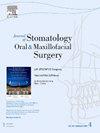骨骼中发现的填充物:24 年后从下颌骨中手术取出聚丙烯酰胺水凝胶(Amazingel):病例报告和文献综述。
IF 1.8
3区 医学
Q2 DENTISTRY, ORAL SURGERY & MEDICINE
Journal of Stomatology Oral and Maxillofacial Surgery
Pub Date : 2024-10-01
DOI:10.1016/j.jormas.2024.101962
引用次数: 0
摘要
聚丙烯酰胺水凝胶(PAAG)被广泛认为是一种安全的软组织填充剂,自 1997 年起在中国被广泛用于整形美容,如隆胸和隆脸,直至 2006 年被禁用。使用这种材料常见的并发症包括炎症、感染、肉芽肿、纤维化、凝胶移位以及面部和软组织畸形。本病例报告描述了一位 45 岁的中国女性,在面部隆鼻 24 年后,PAAG 移入下颌骨,导致下颌牙槽神经受到刺激,这显然是首次出现这种情况。必须进行手术治疗,以清除移位的凝胶和相关钙化物。文献综述探讨了美容手术中 PAAG 并发症的不良事件和处理策略。虽然普遍认为 PAAG 是安全的,但该报告强调了细致的注射技术和仔细选择解剖部位对预防此类严重并发症的重要性。本文章由计算机程序翻译,如有差异,请以英文原文为准。
Filler found in bone: Surgical removal of polyacrylamide hydrogel (Amazingel) from the mandible after 24 years: A case report and literature review
Polyacrylamide hydrogel (PAAG) is widely regarded as a safe soft tissue filler and has been extensively utilized for cosmetic enhancements, such as breast and facial augmentation in China from 1997 until its ban in 2006. Common complications associated with its use include inflammation, infection, granulomas, fibrosis, gel migration, and facial and soft tissue deformities. This case report describes a 45-year-old Chinese woman who experienced PAAG migration into her mandible 24 years after facial augmentation, causing irritation of the mandibular alveolar nerve - apparently the first documented instance of this occurrence. Surgical intervention was necessary to remove the migrated gel and associated calcifications. A literature review explored adverse events and management strategies for PAAG complications in cosmetic procedures. While generally considered safe, this report underscores the importance of meticulous injection techniques and careful anatomical site selection to prevent such severe complications.
求助全文
通过发布文献求助,成功后即可免费获取论文全文。
去求助
来源期刊

Journal of Stomatology Oral and Maxillofacial Surgery
Surgery, Dentistry, Oral Surgery and Medicine, Otorhinolaryngology and Facial Plastic Surgery
CiteScore
2.30
自引率
9.10%
发文量
0
审稿时长
23 days
 求助内容:
求助内容: 应助结果提醒方式:
应助结果提醒方式:


